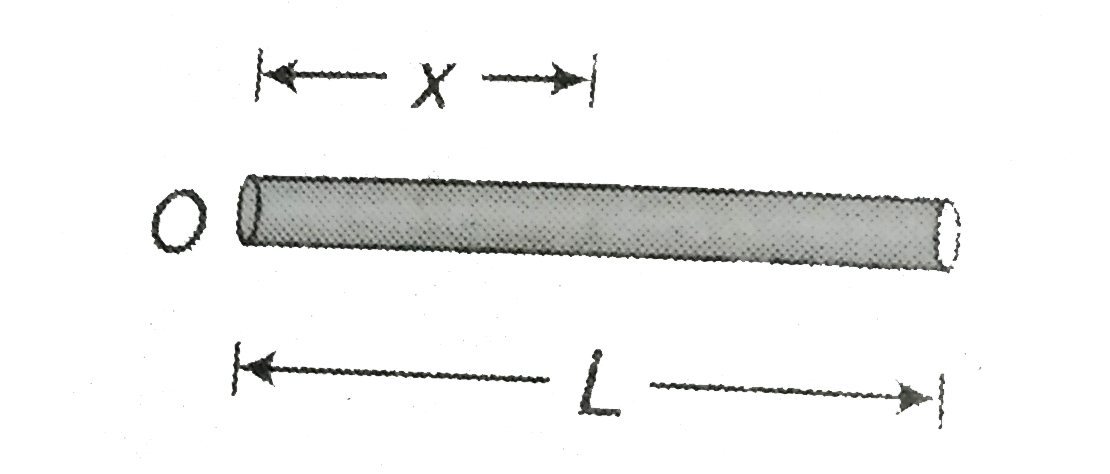The linear density of a rod of length L varies as ρ=A+Bx where x is the distance from the left end. The distance of centre of mass from O is
 Solution in Telugu
Solution in Telugu
3AL+2BL23(2A+BL)
2AL+2BL23(2A+BL)
2AL+2BL24(2A−BL)
2AL−2BL24(2A−BL)
The correct Answer is:A
Step by step video & image solution for The linear density of a rod of length L varies as rho=A+Bx where x is the distance from the left end. The distance of centre of mass from O is by Physics experts to help you in doubts & scoring excellent marks in Class 11 exams.
Updated on:21/07/2023Topper's Solved these Questions
- SYSTEM OF PARTICLES AND ROTATIONAL MOTIONBOOK - AAKASH SERIESCHAPTER - SYSTEM OF PARTICLES AND ROTATIONAL MOTIONEXERCISE - Exercise-II
109 Videos
- SURFACE TENSIONBOOK - AAKASH SERIESCHAPTER - SURFACE TENSIONEXERCISE - ADDITIONAL PRACTICE EXERCISE (PRACTICE SHEET (ADVANCED) INTEGER TYPE QUESTIONS )
8 Videos
- THERMAL PROPERTIES OF MATTERBOOK - AAKASH SERIESCHAPTER - THERMAL PROPERTIES OF MATTEREXERCISE - ADDITIONAL PRACTICE EXERCISE (LEVEL - II) PRACTICE SHEET (ADVANCED) Integer/Subjective Type Questions
2 Videos
Similar Questions
Centre of mass of two particle with masses 2 kg and 1 kg locsted at (1, 0, 1) and (2, 2, 0) has the co - ordinates of
View SolutionIf the work done in blowing a soap bubble of volume 'V' is W, then the work done in blowing a soap bubble of volume '2V' is
View SolutionA constant pressure gas thermometer has a volume of 200cc, 273.2cc and 525 .1cc at 0°C, 100°C and boiling point of sulphur respectively. The resistance possessed by a platinum wire at the same temperatures as above are 2.000Ω,2.778Ωand5.280Ω respectively. Estimate the boiling point of sulphur on the basis of the two sets of observations.
View SolutionThe density of a linear rod of length L varies as ρ=A+Bx where x is the distance from the left end. Locate the centre of mass.

View SolutionA rod of length L is placed along the x-axis between x=0 and x=L . The linear mass density (mass/length) rho of the rod varies with the distance x from the origin as rho=a+bx . Here, a and b are constants. Find the position of centre of mass of this rod.
View SolutionIf the linear density (mass per unit length) of a rod of length 3m is proportional to x, where x, where x is the distance from one end of the rod, the distance of the centre of gravity of the rod from this end is.
View SolutionThe linear mass density i.e. mass per unit length of a rod of length L is given by ρ=ρ0(1+xL), where ρ0 is constant , x distance from the left end. Find the total mass of rod and locate c.m. from the left end.

View Solutionएक छड़ के पदार्थ का घनत्व ρ=A+Bx के अनुसार बदलता है , जहाँ A,B अचर है तथा x, छड़ में बाएँ किनारे से दूरी है | छड़ कि दूरी लम्बाई L है | इसके द्रव्यमान केंद्र कि स्थिति ज्ञात करें |

View SolutionThe density of a linear rod of length L varies as rho = A+Bx, where x is the distance from the left end. Locate the centre of mass.
View SolutionL लम्बाई की रेखीय छड़ का घनत्व ρ=Bx से बदलता है जहां x बाएं सिरे से दूरी है। छड़ का द्रव्यमान केंद्र है
View SolutionIf L is the linear density of the length rod. lamda = A + Bx Calculate the position of the center of mass. (Where x is the distance from one end)
View SolutionA rod of length L is placed along the X-axis between x=0andx=L. The linear density (mass/length) ρ of the rod varies with the distance x from the origin as ρ=a+bx. a.) Find the SI units of a and b b.) Find the mass of the rod in terms of a,b, and L.
View SolutionThe density of a rod of length L varies as ρ=A+Bx where x is the distance from the left end. Locate the centre of mass.

View SolutionIf the linear density of a rod of length L varies as lambda = (kx^(2))/(L) where k is a constant and x is the distance of any point from one end, then find the distance of centre of mass from the end at x = 0.
View SolutionA rod of length L is placed along the x -axis between x = 0 and x = L. The linear density (mass/length) ρ of the rod varies with the distance x from the origin as ρ=a+bx . Here a and b are constants. Find the position of centre of mass of this rod.

View Solution
